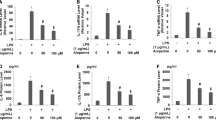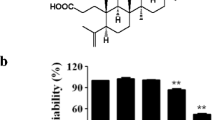Abstract
The salicylic acid derivative 4-tert-butylphenyl salicylate (4-TBPS) possesses anti-inflammatory activity. We demonstrated this and elucidated the mechanisms involved by using the lipopolysaccharide-stimulated Raw 264.7 mouse macrophage model. The 3-(4, 5-dimethylthiazol-2-yl)-2,5-diphenyltetrazolium bromide (MTT) assay, western blot, enzyme-linked immunosorbent assay, and reverse transcriptase-polymerase chain reaction were performed to explore 4-TBPS anti-inflammatory activity. We found that 4-TBPS decreased nitric oxide production without cytotoxic effects on macrophages and reduced expression of inducible nitric oxide synthase (iNOS) and cyclooxygenase (COX)-2 in a dose-dependent manner. Additionally, mRNA expressions of iNOS and COX-2 significantly reduced, with concentrations between 1 and 15 µg/ml. Furthermore, 4-TBPS significantly inhibited the production of pro-inflammatory cytokines including tumor necrosis factor-α (TNF-α), interleukin- (IL)-1β, and IL-6. Moreover, mRNA gene expression of TNF-α, IL-1β, and IL-6 was attenuated in a dose-dependent manner. 4-TBPS potently inhibited translocation of nuclear factor-κB (NF-κB) into the nucleus by degrading IκB kinase (IκBα) following its phosphorylation, thereby causing NF-κB to remain inactive. Collectively, our data indicate that 4-TBPS significantly (p < 0.01) targets the inflammatory response of macrophages via inhibition of iNOS, COX-2, TNF-α, IL-1β, and IL-6 through downregulation of the NF-κB pathway. This indicates that 4-TBPS may have therapeutic potential in inflammatory disorders.







Similar content being viewed by others
References
An SJ, Pae HO, Oh GS, Choi BM, Jeong S, Jang SI, Oh H, Kwon TO, Song CE, Chung HT (2002) Inhibition of TNF-alpha, IL-1beta, and IL-6 productions and NF-kappa B activation in lipopolysaccharide-activated RAW 264.7 macrophages by catalposide, an iridoid glycoside isolated from Catalpa ovata G. Don (Bignoniaceae). Int Immunopharmacol 2:1173–1181
Cheon HJ, Rho YH, Choi SJ, Lee YH, Song GG, Sohn J, Won NH, Ji JD (2006) Prostaglandin E2 augments IL-10 signaling and function. J Immunol 177:1092–1100
Esposito E, Salvatore C (2007) The role of nitric oxide synthases in lung inflammation. Curr Opin Investig Drugs (London, England: 2000) 8:899–909
Farrow B, Evers BM (2002) Inflammation and the development of pancreatic cancer. Surg Oncol 10:153–169
Hacker H, Karin M (2006) Regulation and function of IKK and IKK-related kinases. Sci Stke 357:12–14
Hutchinson E (2003) An aspirin a day. Nat Rev Cancer 3:552
Jachak SM (2007) PGE synthase inhibitors as an alternative to COX-2 inhibitors. Curr Opin Investig Drugs (London, England: 2000) 8:411–415
Karin M (1999) How NF-kappaB is activated: the role of the IkappaB kinase (IKK) complex. Oncogene 18:6867–6874
Karin M, Yixue C, Florian RG, Zhi-Wei L (2002) NF-κB in cancer: from innocent bystander to major culprit. Nat Rev Cancer 2:301–310
Kasama T, Miwa T, Isozaki T, Odai T, Adachi M, Kunkel S (2005) Neutrophil-derived cytokines: potential therapeutic targets in inflammation. Curr Drug Targets-Inflamm Allergy 4:273–279
Kim EH, Shim B, Kang S, Jeong G, Lee J, Yu YB, Chun M (2009) Anti-inflammatory effects of Scutellaria baicalensis extract via suppression of immune modulators and MAP kinase signaling molecules. J Ethnopharmacol 126:320–331
Klimp AH, Harry H, Claudia K, Ate GJ, Elisabeth GE, Toos D (2001) Expression of cyclooxygenase-2 and inducible nitric oxide synthase in human ovarian tumors and tumor-associated macrophages. Cancer Res 61:7305–7309
Madan RK, Jacob L (2014) A review of toxicity from topical salicylic acid preparations. J Am Acad Dermatol 70:788–792
Min KR, Lee H, Kim BH, Chung EY, Cho SM, Kim Y (2005) Inhibitory effect of 6-hydroxy-7-methoxychroman-2-carboxylic acid phenylamide on nitric oxide and interleukin-6 production in macrophages. Life Sci 77:3242–3257
Mosser DM, Xia Z (2008) Interleukin-10: new perspectives on an old cytokine. Immunol Rev 226:205–218
Murakami A, Ohigashi H (2007) Targeting NOX, INOS and COX-2 in inflammatory cells: chemoprevention using food phytochemicals. Int J Cancer 121:2357–2363
Nose F, Ichikawa T, Fujiwara M, Okayasu I (2002) Up-regulation of cyclooxygenase-2 expression in lymphocytic thyroiditis and thyroid tumors significant correlation with inducible nitric oxide synthase. Am J Clin Pathol 117:546–551
Ohshima H (2003) Genetic and epigenetic damage induced by reactive nitrogen species: implications in carcinogenesis. Toxicol Lett 140:99–104
Rajnakova A, Shabbir M, Goh PM, Ngoi SS (2001) Expression of nitric oxide synthase, cyclooxygenase, and p53 in different stages of human gastric cancer. Cancer Lett 172:177–185
Son HJ, Kim YH, Park D, Kim JJ, Rhee PL, Paik SW, Choi KW, Song SY, Rhee JC (2001) Interaction between cyclooxygenase-2 and inducible nitric oxide synthase in gastric cancer. J Clin Gastroenterol 33:383–388
Surh YJ, Na HK, Lee JY, Keum YS (2001) Molecular mechanisms underlying anti-tumor promoting activities of heat-processed Panax ginseng C.A, Meyer. J Korean Med Sci 16:38–41
Vane JR, Mitchell J, Appleton I, Tomlinson A, Bishop-Bailey D, Croxtall J, Willoughby Derek A (1994) Inducible isoforms of cyclooxygenase and nitric-oxide synthase in inflammation. Proc Natl Acad Sci 91:2046–2050
Wadsworth TL, Dennis RK (1999) Effects of the wine polyphenolics quercetin and resveratrol on pro-inflammatory cytokine expression in RAW 264.7 macrophages. Biochem Pharmacol 57:941–949
Wolf AM, Wolf D, Rumpold H, Ludwiczek S, Enrich B, Gastl G, Weiss G, Herbert T (2005) The kinase inhibitor imatinib mesylate inhibits TNF-α production in vitro and prevents TNF-dependent acute hepatic inflammation. Proc Natl Acad Sci USA 102:13622–13627
Yinon BN, Karin M (2011) Inflammation meets cancer, with NF-[kappa] B as the matchmaker. Nat Immunol 12:715–723
Zeilhofer HU, Brune K (2006) Analgesic strategies beyond the inhibition of cyclooxygenases. Trends Pharmacol Sci 27:467–474
Acknowledgments
This work was supported by the National Research Foundation of Korea (NRF) Grant funded by the Korean government (MEST) (2010-0029178) and “Cooperative Research Program for Agriculture Science & Technology Development (Project No. PJ01128901)” Rural Development Administration, Republic of Korea.
Author information
Authors and Affiliations
Corresponding authors
Ethics declarations
Conflict of interest
The authors declare that they have no conflict of interests.
Additional information
Yun Hee Choi and Baek Hee Na both authors contributed equally to this work.
Rights and permissions
About this article
Cite this article
Choi, Y.H., Na, B.H., Choi, Y.S. et al. Anti-inflammatory function of 4-tert-butylphenyl salicylate through down-regulation of the NF-kappa B pathway. Arch. Pharm. Res. 39, 429–436 (2016). https://doi.org/10.1007/s12272-015-0679-3
Received:
Accepted:
Published:
Issue Date:
DOI: https://doi.org/10.1007/s12272-015-0679-3




